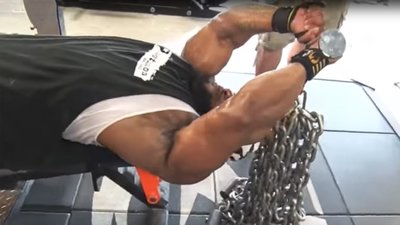The Irish playwright George Bernard Shaw famously wrote, "All great truths begin as blasphemies." I agree. That's why this workout will include some moves that might ruffle a few feathers among bodybuilding purists. At Bodybuilding.com, we want to give you the truth, even if it's not standard operating procedure. From functional isometrics to doing skull crushers with chains, these exercises will get you thinking in new ways and blowing up your arms to new dimensions.
1. Functional Isometric Close-Grip Bench Press
Functional isometrics are old-school favorites of people like Bob Hoffman and Anthony Ditillo. I myself learned them from Charles Poliquin. What's so great about isometrics? How about the fact that you can produce approximately 15 percent more force isometrically than you can concentrically? That's good news for all lifters, because higher force output means greater adaptive overload for size and strength.
About the Movement
An isometric contraction is a muscular contraction where the joint angle and muscle length do not change. Like partial overloads, isometric contractions have a localized training effect for strength. That makes them a great technique for overcoming sticking points in powerlifting.
The wise powerlifter combines isometrics with conventional lifting; the wise bodybuilder does the same. Science has shown that isometric bodybuilding poses can increase hypertrophy. If simple bodybuilding poses are like powering your muscle building with a strong V-8, then poses that include functional isometrics are like attaching it to a Roush 570 HP Supercharger.
Training Tips
- Put a bench inside a power rack and set the pins to approximately two inches below lockout.
- Using a close-grip, bench press the barbell into the pins. Just make contact with the pins then return to the starting position. Do this for five repetitions.
- On the sixth rep, push the barbell as hard as you can against the pins. Hold that press for 6 seconds before returning back down to the starting position.
Do this for three sets, starting with your eight-repetition max. Reduce the weight as needed on the subsequent sets.
Bonus Tip: When you're pushing isometrically, imagine that you're trying to snap off the pins with sheer force. Pushing against the pins at anything but maximum force will deprive you of max size and strength gains.
2. Eccentric/Isometric Contrast Hammer Curls
If you don't take the time to develop your brachialis, you're never going to get maximum growth of what the lay public refers to as your "biceps." The brachialis sits between the biceps and triceps. As you increase its size, it pushes the biceps muscles farther and farther away from one another, creating the look of a wider upper arm and a more pronounced peak.
About the Movement
This exercise is going to target the brachialis like it's never been targeted before, by hammering it with isometric hammer curls.
Training Tips
- Start in a standing position with a dumbbell in each hand.
- Do this exercise one arm at a time. With your right elbow fully extended and close to your side, and your palm facing inward in a neutral grip, curl the weight up until your elbow flexors are fully contracted. Lower the weight at a controlled pace.
- Here's the kicker: At 15 degrees shy of full extension, stop and hold the weight for 3 seconds to isometrically overload your arm.
- Lower the weight to full extension and repeat for the desired number of reps. Switch to your left arm and repeat.
The adaptive overload for hypertrophy is huge here because all three types of muscular contractions are overloaded. This movement will be performed in an alternating-arm fashion, for three sets of four reps on each arm. Reduce the weight for each set as needed.
Bonus Tip: Start with approximately two-thirds of the weight you can use on traditional hammer curls for three sets of four reps. If you can normally lift 30 pounds, start with 20 pounds.
3. V-Handle Chain Triceps Extensions
For decades, bodybuilders have been on the cutting edge of nutrition and supplementation. But when it comes to training, this same group can seem very averse to change. If you are willing to open up your mind, I can show you how to overload your triceps, while using chains to minimize elbow pain.
About the Movement
What? Bodybuilders using chains? Yes! Smart powerlifters borrow from bodybuilders, and smart bodybuilders should reciprocate.
Heavy skull crushers have helped build the greatest sets of triceps in human history—eight-time Mr. Olympia Ronnie Coleman, for example. These common exercises have a drawback though: They put a lot of stress on the elbow joint, which can lead to pain and injury.
The difference between these extensions and traditional skull crushers is that by using chains, you increase the load with every link of the chain you lift off the floor, and decrease the load as you lower the chain back down. Increasing and then decreasing the load this way matches the strong and weak points of your elbow.
In effect, the exercise increases the load as you are able to recruit more muscle fibers to deliver the most strength. The V-handle chain triceps extension lands in a nice spot on the risk-to-benefit continuum. By performing triceps extensions with chains, you move the weight but avoid the risk.
Training Tips
- Using a carabiner, attach chains to a triceps V-handle.
- Lie down on a flat bench and perform a triceps extension by lifting the chains off the floor.
- When you do the negative downward motion, lower the weight at a steady 5-second negative, with your speed constant from top to bottom. Moving slowly through this portion will both increase muscle time under tension and reinforce the mind/muscle connection.
Perform this movement as heavy as possible for four sets of eight repetitions.
Bonus Tip: If this movement still doesn't relieve your elbow pain, exchange it for cable lying triceps extensions.
4. Incline Cable Curls
The inclined position you'll use for this exercise positions your elbows behind your body, thus recruiting the long head of the biceps.
About the Movement
The dumbbell version of this exercise was popularized by pioneering bodybuilder turned Tinseltown star Steve Reeves. In Reeves' era, his bicep development was unmatched! Admittedly, the stretch overload in this classic movement is partially negated with cables. But it's still induced—if to a lesser degree. Unlike dumbbells, the cables inflict continuous tension to provide a very large benefit with a very small risk.
Training Tips
Think form over function. You have to perform these curls 100 percent to form. If you move your elbows too far in front of your body, you have just cancelled the desired training effect.
Perform this movement for three sets of 12 reps at a controlled pace, emphasizing stretch and strict execution.
Bonus Tip: If you don't have a dual cable setup, try Smith machine drag curls.



